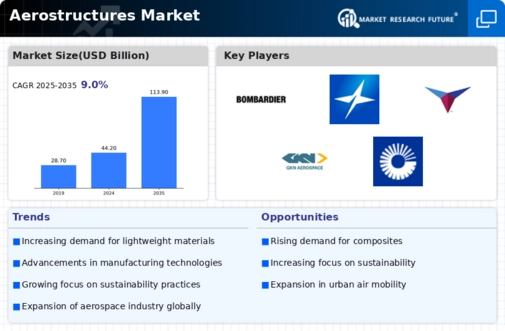Market Trends
Key Emerging Trends in the Aerostructures Market
In the competitive Aerostructures Market, companies need to have market share positioning strategies in order to become established and gain a competitive advantage. One of the most important strategies is differentiation through technological innovation. Given that aerospace manufacturers are expected to lead in terms of technology advancements, it is paramount for them to invest heavily in Research and Development (R&D) so as to bring forth cutting-edge materials, advanced manufacturing processes and innovative design concepts for aerostructures. This positions such firms favorably because they can offer better technological solutions that attract airplane makers who want state-of-the-art aerostructures that boost performance, fuel efficiency or general capabilities of their aircrafts.
Partnership and collaboration strategies play crucial roles in determining market shares within the Aerostructures Market. Due to complexity of aerostructure manufacturing and assembly, companies usually create alliances with other players in the aerospace industry, research institutions or vendors. Consequently, these partnerships promote sharing of knowledge, resources as well as joint studies thereby leading to more comprehensive and sophisticated aerostructure solutions. Companies involved in strategic partnerships often project an enhanced capability front with wider product range and collaborative approaches towards meeting requirements posed by aircraft programs hence influencing their market share positively.
A customer-centric approach is paramount when gaining or expanding market hold within Aerostructures Market. Specific needs and demands of aircraft manufacturers enable aerostructure suppliers to customize their products accordingly. Customer satisfaction can be achieved through customization options lightweight solutions as well as concentrate on efficiency factors during manufacturing process . Developing strong relationships with airline makers through effective after-sales support systems training programmes responsive maintenance services help secure loyal customers’ base while positioning firms as preferred suppliers within highly-competitive aerostructures industry.
Cost leadership is an essential strategy for positioning oneself within the Aerostructures Market’s market share. The competitiveness of the aerospace industry coupled with high costs involved in manufacturing aerostructure forces companies indulged in this business line strive towards achieving cost-effective solutions without compromising quality or aspects of efficiency. Efficient production processes, economies of scale and strategic sourcing contribute to competitive pricing, thus making these suppliers attractive to airplane manufacturers who seek value for their investments. However, turning into a cost leader not only helps attract customers on a tight budget but also makes companies become dependable providers of affordable yet high-quality aerostructure solutions; something that is crucial within markets with strong price constraints.
Companies looking forward to expanding their market share in the Aerostructures Market employ global market expansion as a strategic approach. Manufacturers can increase their customer base by targeting new geographical locations and entering emerging aerospace markets. Successful market expansion requires adaptation of aerostructures to suit specific requirements of diverse regions alongside an understanding of geopolitical and operational peculiarities. For instance, by strategically aligning with the aerospace priorities of different nations, firms can position themselves as global players hence capturing fresh opportunities while increasing overall market shares.
In order to maintain its competitive market share within the Aerostructures Market continuous product development and innovation are very important. In response to changes in the needs of aircraft manufacturers, companies need to keep up with developments in the aerospace industry. Regularly updating and improving aerostructures ensures that manufacturers remain relevant and capable of providing the latest advancements in technology. Companies therefore maintain their positions or even gain more market share by offering cutting-edge products line which always adapt to changing needs or standards imposed by programs on aircrafts.
Market share dynamics within the Aerostructures Market are also influenced by marketing and brand positioning strategies. When a brand is strong and reputable, it gives manufacturers of aircraft confidence and influences their purchasing decisions. Other factors that enhance brand visibility and perception are efficient sales promotions in addition to participation in aerospace industry events as well as successful deployments of aerostructures. A company’s success in positioning itself as a trusted and dependable supplier will increase its market share in this fast-paced, changing environment."








Leave a Comment